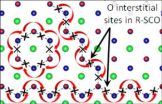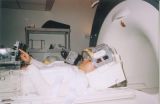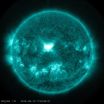(Press-News.org) RICHLAND, Wash. -- Researchers have been trying to increase the efficiency of solid oxide fuel cells by lowering the temperatures at which they run. More efficient fuel cells might gain wider use in vehicles or as quiet, pollution-free, neighborhood electricity generating stations. A serendipitous finding has resulted in a semiconducting material that could enable fuel cells to operate at temperatures two-thirds lower than current technology, scientists reported August 18 in Nature Communications.
In an attempt to create a metal oxide with the properties of metal, researchers at the Department of Energy's Pacific Northwest National Laboratory created a new form of the metal oxide. This particular strontium-chromium oxide performs as a semiconductor, or a material whose ability to conduct electricity can be turned on and off. It also allows oxygen to diffuse easily, a requirement for a solid oxide fuel cell. Best yet, it allows diffusion at a temperature that can lead to much more efficient fuel cells.
Nothing is Something
Energy researchers need improved materials to make fuel cells more widely used. Solid oxide fuel cells require oxides capable of absorbing and transmitting negatively charged oxygen atoms at low temperature. Current materials require temperatures around 800 degrees Celsius (for reference, car engines run at about 200 degrees Celsius and steel melts around 1500).
Researchers at PNNL were trying to make strontium chromium oxide in a kind of crystalline form called perovskite, which has many useful electronic properties. In this material, the strontium, chromium and oxygen atoms stack together in a cube. The metal atoms -- strontium and chromium -- bond completely to the oxygen atoms around them.
However, in the material that formed, the strontium chromium oxide packed into a rhombus-shaped crystal -- think diamond -- and many of the oxygen atoms were missing.
What's more, the holes where the oxygen atoms had been, also called oxygen vacancies, had come together to form well-defined planes within the new crystal structure. The researchers found that these planes act as channels that allow oxygen from outside the material to diffuse through the material at an exceptionally low temperature for these materials, about 250 degrees Celsius.
"At high enough concentrations, oxygen vacancies aggregate and form new mesoscale structures with novel properties that the original material doesn't have," said PNNL materials scientist Scott Chambers, who led the research. "In this case, the mesoscale crystalline structure transmits oxygen very efficiently."
Bad Angle Bonds
The scientists inadvertently generated the material by taking advantage of the natural tendency of chromium atoms to avoid certain bonding environments. They found that their attempts to make metallic SrCrO3 (strontium chromium oxide in a ratio of 1:1:3) lead instead to the formation of semiconducting SrCrO2.8 (with a ratio of 1:1:2.8).
Because chromium as an ion with a charge of +4 does not like to form 90o bonds with oxygen, as it must in SrCrO3, SrCrO2.8 forms instead with a completely different crystal structure. This material contains oxygen-deficient regions through which oxygen can diffuse very easily. Those regions might provide a way to take better advantage of the material's electronic properties.
"As an additional benefit, ordered arrays of oxygen vacancies might allow us to separate the material's electronic and thermal properties," said Chambers. "This would help us improve the performance of thermoelectrics, in either generating power from heat or for use in refrigeration."
The team made ultra-pure crystalline films of the new material and used instruments and expertise at EMSL, DOE's Environmental Molecular Sciences Laboratory, to understand the material's properties. A DOE Office of Science User Facility, EMSL scientists worked with Chambers to develop a new instrument called an oxygen-assisted molecular beam epitaxy deposition system that is specifically designed to make and study these kinds of crystalline films.
Towards Light and Electrons
In the future, the team plans to apply the understanding gained to other materials, such as the deposition, characterization, and understanding of epitaxial strontium-doped lanthanum chromite, which has potential importance in visible light harvesting.
In the long term, the team plans to exploit the observed phenomenon to carry out nanofabrication of novel heterogeneous catalytic structures by depositing submonolayer quantities of catalytically important metals on the surface of rhombus-shaped, semiconducting oxide, and using the intersection of the defect planes with the free surface to order the incoming metal atoms into nanowires.
INFORMATION:
This work was supported by the Department of Energy Office of Science, EMSL and PNNL.
Reference: Hong-Liang Zhang, Peter V. Sushko, RJ Colby, Yingge Du, Mark E. Bowden , and Scott A. Chambers. 2014. Reversible Nano-Structuring of SrCrO3-δ Through Oxidization and Reduction at Low Temperatures. Nature Communications, August 18, 2014. DOI: 10.1038/ncomms5669.
Interdisciplinary teams at Pacific Northwest National Laboratory address many of America's most pressing issues in energy, the environment and national security through advances in basic and applied science. Founded in 1965, PNNL employs 4,300 staff and has an annual budget of about $950 million. It is managed by Battelle for the U.S. Department of Energy's Office of Science. As the single largest supporter of basic research in the physical sciences in the United States, the Office of Science is working to address some of the most pressing challenges of our time. For more information on PNNL, visit the PNNL News Center, or follow PNNL on Facebook, Google+, LinkedIn and Twitter.
EMSL, the Environmental Molecular Sciences Laboratory, is a national scientific user facility sponsored by the Department of Energy's Office of Science. Located at Pacific Northwest National Laboratory in Richland, Wash., EMSL offers an open, collaborative environment for scientific discovery to researchers around the world. Its integrated computational and experimental resources enable researchers to realize important scientific insights and create new technologies. Follow EMSL on Facebook, LinkedIn and Twitter.
Angling chromium to let oxygen through
New semiconducting material works at temperatures low enough to improve fuel cell efficiency
2014-09-10
ELSE PRESS RELEASES FROM THIS DATE:
Association between sunshine and suicide examined in study
2014-09-10
Lower rates of suicide are associated with more daily sunshine in the prior 14 to 60 days.
Light interacts with brain serotonin systems and possibly influences serotonin-related behaviors. Those behaviors, such as mood and impulsiveness, can play a role in suicide.
The authors examined the relationship between suicide and the duration of sunshine after mathematically removing seasonal variations in sunshine and suicide numbers. They analyzed data on 69,462 officially confirmed suicides in Austria between January 1970 and May 2010. Hours of sunshine per day were ...
Study examines vitiligo, alopecia areata and chronic graft vs. host disease
2014-09-10
Vitiligo (depigmentation of the skin) and alopecia areata (AA, patchy or complete hair loss) in patients with chronic graft-vs-host disease (GvHD) following a stem cell transplant appear to be associated with having a female donor and the sex mismatch of a female donor and male recipient.
GvHD is a frequent complication of donor stem cell transplants because donor cells can attack the recipient's body and cause death and other illnesses. The skin is the most commonly affected organ. The underlying biology of chronic GvHD has not been fully explained. The authors ...
'Green wave' explains migratory bird routes
2014-09-10
Ithaca, N.Y.—Migratory songbirds enjoy the best of both worlds—food-rich summers and balmy winters—but they pay for it with a tough commute. Their twice-a-year migrations span thousands of miles and are the most dangerous, physically demanding parts of their year.
Surprisingly, for many North American species the best route between summer and winter homes is not a straight line, according to new research published in the Proceedings of the Royal Society B. In spring, the study shows, birds follow areas of new plant growth—a so-called "green wave" of new leaves and numerous ...
York U neuroscientists decode brain maps to discover how we take aim
2014-09-10
TORONTO, Sept. 10, 2014 - Serena Williams won her third consecutive US Open title a few days ago, thanks to reasons including obvious ones like physical strength and endurance. But how much did her brain and its egocentric and allocentric functions help the American tennis star retain the cup?
Quite significantly, according to York University neuroscience researchers whose recent study shows that different regions of the brain help to visually locate objects relative to one's own body (self-centred or egocentric) and those relative to external visual landmarks (world-centred ...
Happy Camp Fire in California and 790 Fire in Oregon
2014-09-10
The 790 Fire in Oregon began as a lightning strike on July 31, 2014. Over 3,000 acres have been affected by this fire which is 54% contained. In the next 12 to 48 hours there is a potential risk to Sky Lakes Wilderness and natural resources including the Northern Spotted Owl habitat, Coho habitat, water quality, the Pacific Crest Trail, and Cherry Creek Research Natural Area. Area and trail closures exist on the Pacific Crest Trail. The weather is not helping the fire fighters with gusty winds and low relative humidity. The operational objectives include keeping the ...
Diverse neighborhoods may help infants' social learning
2014-09-10
Experiencing diverse communities by hearing different languages at the park, on a bus or in the grocery store may make babies more open-minded in their social learning, a new study finds.
While previous research has shown that direct interactions with parents and caregivers shape early cognitive development, the influence of the broader community beyond those direct experiences has not been as carefully examined. In a new study published by the journal Cognition, University of Chicago Psychology Department researchers investigated whether the variety of languages in infants' ...
Will the real unemployment rate please stand up?
2014-09-10
PRINCETON, N.J.—America's unemployment rate — most recently reported as 6.1 percent — has long been used to gauge the country's economic well-being. But a new working paper released by Princeton University's Woodrow Wilson School of Public and International Affairs highlights the difficulty in estimating the exact unemployment rate, though changes in the official measure still signal important movements in the economy.
The research, published by the National Bureau of Economic Research, finds that the true unemployment rate may be higher or lower than recent reports ...
Sequencing and analysis of gibbon genome sheds light on its complex evolution
2014-09-10
PORTLAND, Ore. — A team led by an Oregon Health & Science University researcher has sequenced and annotated the genome of the only ape whose DNA had yet to be sequenced — the gibbon, an endangered small ape that inhabits the tropical forests of Southeast Asia.
The team's work, published in the Sept. 11 edition of Nature, gives scientists new insight into the evolution of the gibbon genome and its extraordinary number of chromosomal rearrangements. Chromosomal rearrangements are structural changes in the DNA that are often problematic in other species — including causing ...
Gibbon genome and the fast karyotype evolution of small apes
2014-09-10
BATON ROUGE – LSU's Mark Batzer, LSU Boyd Professor and Dr. Mary Lou Applewhite Distinguished Professor, along with Research Assistant Professor Miriam Konkel and Research Associate Jerilyn Walker in Department of Biological Sciences in the College of Science, contributed to an article featured on the cover of the scientific journal Nature, titled "Gibbon Genome and the Fast Karyotype Evolution of Small Apes."
An abstract of the article can be found at http://www.nature.com/nature/journal/v513/n7517/full/nature13679.html?WT.ec_id=NATURE-20140911. The issue of Nature will ...
NASA sees a significant flare surge off the sun
2014-09-10
The sun emitted a significant solar flare, peaking at 1:48 p.m. EDT on Sept. 10, 2014. NASA's Solar Dynamics Observatory captured images of the event.
Solar flares are powerful bursts of radiation. Harmful radiation from a flare cannot pass through Earth's atmosphere to physically affect humans on the ground. However -- when intense enough -- they can disturb the atmosphere in the layer where GPS and communications signals travel.
To see how this event may affect Earth, please visit NOAA's Space Weather Prediction Center at http://spaceweather.gov, the U.S. government's ...
LAST 30 PRESS RELEASES:
Young adults commonly mix cannabis with nicotine and tobacco
Comprehensive review illuminates tau protein's dual nature in brain health, disease, and emerging psychiatric connections
Book prepares K-12 leaders for the next public health crisis
Storms in the Southern Ocean mitigates global warming
Seals on the move: Research reveals key data for offshore development and international ecology
Sports injuries sustained during your period might be more severe
World's first successful 2 Tbit/s free-space optical communication using small optical terminals mountable on satellites and HAPS
Can intimate relationships affect your heart? New study says ‘yes’
Scalable and healable gradient textiles for multi‑scenario radiative cooling via bicomponent blow spinning
Research shows informed traders never let a good climate crisis go to waste
Intelligent XGBoost framework enhances asphalt pavement skid resistance assessment
Dual-function biomaterials for postoperative osteosarcoma: Tumor suppression and bone regeneration
New framework reveals where transport emissions concentrate in Singapore
NTP-enhanced lattice oxygen activation in Ce-Co catalysts for low-temperature soot combustion
Synergistic interface engineering in Cu-Zn-Ce catalysts for efficient CO2 hydrogenation to methanol
COVID-19 leaves a lasting mark on the human brain
Scientists use ultrasound to soften and treat cancer tumors without damaging healthy tissue
Community swimming program for Black youth boosts skills, sense of belonging, study finds
Specific depressive symptoms in midlife linked to increased dementia risk
An ‘illuminating’ design sheds light on cholesterol
Who is more likely to get long COVID?
Study showcases resilience and rapid growth of “living rocks”
Naval Research Lab diver earns Office of Naval Research 2025 Sailor of the Year
New Mayo-led study establishes practical definition for rapidly progressive dementia
Fossil fuel industry’s “climate false solutions” reinforce its power and aggravate environmental injustice
Researchers reveal bias in a widely used measure of algorithm performance
Alcohol causes cancer. A study from IOCB Prague confirms damage to DNA and shows how cells defend against it
Hidden viruses in wastewater treatment may shape public health risks, study finds
Unlock the power of nature: how biomass can transform climate mitigation
Biochar reshapes hidden soil microbes that capture carbon dioxide in farmland
[Press-News.org] Angling chromium to let oxygen throughNew semiconducting material works at temperatures low enough to improve fuel cell efficiency





